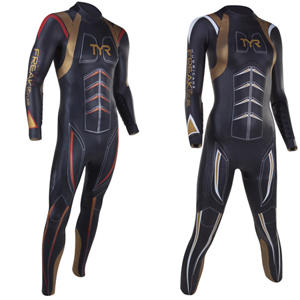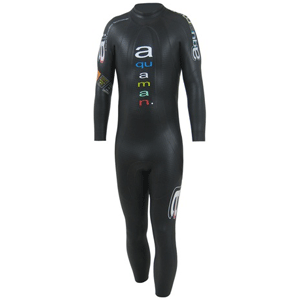
What we often read on forum boards like the one attached to this site is: "Buy the one that fits." That well worn axiom is an appropriate place to begin with this wetsuit.
Let's take me as an example. I'm 6'2" and about 168lb. Orca's size chart gives me these options:
Size MT: Height - 5'10" to 6'2"; Weight - 149 - 167
Size 7: Height - 5'8" to 6'1"; Weight - 165 - 180
Size 8: Height - 5'11" to 6'2"; Weight - 180 - 196
Weightwise, I'm closer to size 7, and in fact size 7 is what I swam in for this test. Heightwise, I'm a better fit in the MT. Even [slightly] better yet heightwise in the size 8, but, the size 8 will have circumferences too big for me—I'm too thin for that size.
When I made wetsuits, this is what bedeviled me. We were always chasing our tails, making yet another size for a cohort of swimmers we were not able to fit. In the end, we had a set of sizes: XS, S, MS, M, ML, L and XL, that fit men of a relatively slender build. Plus women's sizes.
But then we had to add a range of "short" sizes, so, S-Short, M-Short, ML-Short, and so forth. These were for the fireplugs: for example, somebody who weighed what I weighed, but instead of standing 6'2" stood 5'9" or 5'10".
In the end, we offered wetsuits in 16 or 17 sizes that I remember, maybe more.
This is the argument for 2-piece suits. Not that 2-piece suits are better than 1-piece, rather that if you don't want to face this problem, 2-piece suits are the answer; they're the solution when a 1-piece suit won't fit or when, as a retailer, you just can't face stocking that many SKUs.
Orca's suits in 2012 don't fit like my old QR suits did back in the 1980s and 1990s, because I built suits to fit me, and those built like me. You? You were on your own. Unless and until we built a size that fit you.
Orca's suits—the standard size chart, sizes 4, 5, 6 and so forth—are not built to fit people like me. The height ranges are scaled shorter. These standard, numbered sizes are skewed more toward our "short" range of sizes we made when I was at QR—I'd say Orca's suits split the difference between our standard and our short sizes.
This is not bad. It's not good. It just is. The reason we made the short range is that there were so many people we couldn't fit. In a way, Orca's sizes are more cleverly designed than ours were at QR, because our initial sizing was designed for taller and thinner racers, rather than average racers. That required us to introduce a size run for those who were shorter in stature.
When I put on a size-7, well, the middle of this size range is 5'10". I'm 6'2". The arms are short on me, the legs are short, and the torso's short. But, my next door neighbor, Monty, he's 5'9" and 170lb. Orca's size 7 fits him quite nicely.
I'm probably better in Orca's size MT (medium tall). This is an anomalous size, stuck in there for folks like Chris McCormack. I don't know if this is the size Macca swims in, but, I would bet it is. It wouldn't surprise me if this size were created especially for this athlete, who's one of Orca's premier ambassadors. If I were Orca, I'd replicate this motif, scaling this size down one step, and up one step.
My counsel is this: These suits will fit you very nicely if you're in the Orca size chart's weight range, and if you are at the bottom, or in the middle, of the height range, or anywhere in between. If you're near or at the top end of the height range, either you're the next size up, or a TYR, an Aquaman, or a 2XU, is going to fit you better.
Unless you might be a size MT in Orca's range.
Now, about the suit itself. Very interesting ideas in this suit. The first thing you notice is how light the suit is, when you pick it up. Why? Because the entire suit is made of Yamamoto #40 rubber—which is light—and the suit's rubber panels are generally thinner, which makes it yet lighter. But, there's this huge panel of what seems like Aerodome rubber sewn in roughly where a cycling bib's chamois would be, but, quite a bit larger in size than a chamois. This panel is the suit's "Excocel" system that floats the swimmer just as would a swim buoy stuck between your thighs. The idea is to drive the bottom of the body higher relative to the top (or, while swimming, the leading edge) of the body.
It's a great fullsuit for those who most ardently hate fullsuits (really good swimmers from swim backgrounds). If you get Andy Potts, Cameron Dye, Dustin and Sara McLarty, and their ilk, into a room and asked them to agree on one rule they'd like to enact, I don't know what they'd say. But I wouldn't be surprised if they elected to ban fullsuits. Good swimmers don't like fullsuits. But they must swim in them because fullsuits are faster, and they can't give up the speed advantage—even though that advantage accrues to slower swimmers to a greater degree than to faster swimmers.
Fullsuits force you to swim correctly. Good swimmers already do swim correctly. But bad swimmers don't, and fullsuits correct bad technique. To wit, take a look at these swimmers, and note how, after the catch, their hands stay near the top of the water during the extend phase, and then the entire forearm creates a pulling surface, by bending at the elbow, with the upper arm remaining parallel to the surface of the water.
Try to swim this way at your next swim session. Then take your wetsuit to the pool and try to swim this way. Take your wetsuit off, and try it again. Note how easy it is to keep your hand near the surface after the catch. This is because you just got done swimming this proper way in your fullsuit. Fullsuits help you front-quadrant swim. In fact, the less flexible the rubber in a wetsuit, the less freedom you have, and the more fullsuits force you to front-quadrant swim. (As an aside, I think something like a pull buoy for your arms, in the form of wetsuit "arms", for use as a swim aid to teach high-elbow anchor wouldn't be a bad idea for a product.)
Really good swimmers already swim like this. Put on a fullsuit, and you—the journeyman swimmer—are getting a mechanical aid that good swimmers don't need.
This wetsuit featured here—the Orca Alpha—is designed for these good swimmers. It's a minimalist wetsuit, in terms of thicknesses. It's extremely flexible. It's the fullsuit for those who are already good swimmers.
But a suit entirely out of #40 Yamamoto is an extremely stretchy suit, and you'll have to be careful. One thing about this suit, and about certain suits on the very upper end made by TYR: you've got to be quite careful with them. Yamamoto's #39 rubber is not quite so stretchy, yet it's more durable and less prone to tearing.
When I swam in this suit, I chose a new HUUB suit for comparison. I swam four sets of 4 x 100 SCY, repeating on the 1:30 base. I've lost a bit of swim fitness over the past few weeks, so, these times should not be used as a basis for comparison against times in other suits.
I've chosen the HUUB Archimedes 3.5 to test the Alpha against, because each of these suits is similar in theme. Each takes the daring step of removing thickness from the chest, floating the hips and legs higher, to correct body posture. Does this work? Well, I don't know. There's a competing school of that says Just float the damned thing! I don't note a significant decrease in speed over suits that are 5mm throughout. But I don't notice an increase either. Maybe I'm just not technically good enough in the water to make either of these suits work better for me than their 5mm contemporaries.
2012 Orca Alpha
1:11
1:12
1:13
1:12
2012 Orca Alpha
1:12
1:12
1:12
1:12
2012 HUUB Archimedes 3.5
1:12
1:12
1:12
1:12
2012 HUUB Archimedes 3.5
1:12
1:12
1:12
1:12
As noted, both the Orca Alpha and the HUUB Archimedes 3.5 are designed with a similar intent. There is no doubt that, speedwise, the bottom half is the most important part of the suit. De Soto makes a product called a Speedtube, and its just a wetsuit from the waist down. It's a pretty fast suit, that is, it's a lot faster than were you to wear the converse: a wetsuit from the waist up.
Still, for me, I'm pretty sure I'm slightly faster in a typical fullsuit, that has 5mm rubber in the chest. Orca makes that suit, and it's the 3.8. I'll be testing this year's 3.8 upcoming, and while I already know this is the suit in Orca's line that I like best, I'll swim it against another suit and report back the results. HUUB also makes suits that are more typical in construction, and I'll be presenting this as well.


